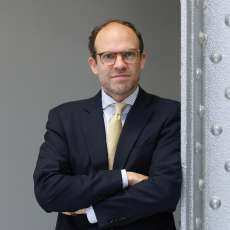Could you briefly introduce yourself and your work on the future of work and as the Founder of the eponymous program at the Oxford Martin School?
Back in 2012, my colleague Michael Osborne and I realized that most economists and leaders were not up to speed with what machines were becoming capable of. People believed machines could only handle routine, rule-based tasks that could be written into code. But machine learning was shifting that—machines were learning to infer rules from the data trails we leave behind, which opened up automation to areas like diagnostics and driving.
We realized that this transformation would impact jobs, income and livelihoods, and since work is a huge part of people’s lives, it was vital to understand these changes. As economists interested in labor markets, it was an exciting and critical moment to study how technological change intersects with employment.
Would you say that artificial intelligence is now the central issue when thinking about the future of work?
I think it is. It has been on some people's radar for quite a while, but it only really hit the public consciousness with OpenAI's release of ChatGPT. Suddenly, everyone began using AI actively, even though we had passively used it before—for instance, in search engines or shopping recommendations.
The arrival of generative AI made people much more aware of the ongoing transformation. It made the coming changes visible and immediate, highlighting how these tools could impact many aspects of our lives and work.
Do you think there will be winners and losers from AI, as with other large-scale technological changes in history?
Yes, almost any change creates winners and losers. That same dynamic applies to technological advances. Even something like electric light—clearly superior to oil lamps—resulted in job losses for lamplighters on day one.
Lamplighters even went on strike in cities like Brussels and clashed with the authorities. These shifts can lead to social upheaval, particularly when jobs are replaced. Not all technologies do that—telescopes enabled new discoveries without replacing jobs, but automatic elevators directly displaced operators. Labor-replacing technologies often bring more unrest and more visible losers.
Is generative AI likely to impact middle-income workers most significantly?
Historically, the middle class has already been hollowed out by automation of routine, rule-based jobs, both in offices and manufacturing. These were typically middle-income roles, and they've been reduced by computers and industrial robots. With AI, the effects are less clear. In the U.S., inequality stopped growing around 2014, partly because wages at the lower end rose, while top earners also pulled ahead.
So, middle-income workers felt squeezed—those below caught up while those above pulled away. AI could either exacerbate or reduce that trend. For instance, great writers or coders aren’t significantly aided by AI, but average or poor ones can improve significantly. Tools like ChatGPT and GitHub Copilot lower entry barriers, making it easier for novices to compete. That helps some workers rise, but may also pressure incumbents.
Does this mean AI could flood the market with average-level content and increase demand for higher-quality work?
Yes, that is an important point about shifting demand. Even if content becomes cheaper or better, your ability to consume it remains limited by time. Say the price of Netflix halves and the content improves—you still only have 24 hours in a day.
AI can help summarize and process more content, but there is still a hard limit. So, while the supply of average content may grow, it won’t necessarily be matched by increased consumption, and high-quality content may become more valuable as a result.
What is your advice to CEOs and business leaders navigating these shifts?
Periods of technological change bring great uncertainty. Most people learn about AI by using it, not from books.
Early on, it is essential to experiment—but organizations need to create incentives for that. If employees are rewarded only for narrow tasks, they will not invest time experimenting, and innovation is stifled.
Evidence from the early computer revolution shows decentralized firms—where lower-level employees had decision-making power—performed better. I expect the same with AI. People closest to its use cases understand it best, so empowering them is key. We've already seen AI adoption associated with less hierarchical structures, and countries like the U.S. and those in Scandinavia, which are more decentralized, outperformed others in past tech shifts.
You contributed to an article in the Financial Times suggesting that robots and AI won’t solve the U.S. manufacturing reshoring problem. Could you explain why?
As countries like the U.S. look to reshore manufacturing, AI and robots can help reduce costs and improve competitiveness. However, they will not bring back large numbers of jobs. Manufacturing jobs are declining globally as a share of employment—even in China, which is the largest market for robots, the number of such jobs has been falling since 2017.
In lower-wage countries like Vietnam and Thailand, robots are now cost-effective, so automation is rising there too. If the goal of reshoring is national security, that is different—but if it is about employment, AI and robotics are unlikely to solve that issue. They reduce the labor needs of manufacturing, not increase them.
What do we now know about the long-term impact of remote work following the COVID-19 pandemic?
In the U.S., remote work peaked at about 60% of hours during the pandemic, then stabilized at around 25%. Patterns differ by country—remote work is more common in high-trust societies and where commutes are long, like London. It brings benefits such as better well-being and schedule flexibility, especially for families.
But there are drawbacks in terms of productivity and innovation. Remote work is fine for routine tasks, like call centers, where people are even more productive at home. But for mentoring, collaboration and creativity, in-person interaction matters. Hybrid work offers a balance—stay home for focused tasks, go in for teamwork, innovation, and training. The two-day hybrid model has stabilized and seems to be working well.
With the rise of online learning and declining emphasis on degrees, do you believe traditional university education will remain relevant?
I do believe that ambitious learners can succeed without a university, but networks still matter, and universities are also social institutions. At Oxford, we offer something distinct—the tutorial system. We teach in small groups, focus on essay writing, debate, and develop creative and social skills that remain valuable.
If a university’s only offering is a weekly lecture, that is replicable online, and students may be better off with digital resources. Higher education institutions must go beyond just transmitting information. They must evolve to provide value in ways technology cannot replicate. Oxford has endured for over 700 years—it has weathered many changes, and I believe it will adapt again.





